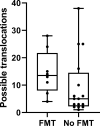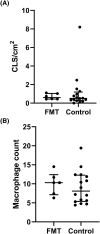Fecal microbiota transplantation does not alter bacterial translocation and visceral adipose tissue inflammation in individuals with obesity
- PMID: 35127122
- PMCID: PMC8804924
- DOI: 10.1002/osp4.545
Fecal microbiota transplantation does not alter bacterial translocation and visceral adipose tissue inflammation in individuals with obesity
Abstract
Aims: Visceral adipose tissue inflammation is a fundamental mechanism of insulin resistance in obesity and type 2 diabetes. Translocation of intestinal bacteria has been suggested as a driving factor for the inflammation. However, although bacterial DNA was detected in visceral adipose tissue of humans with obesity, it is unclear to what extent this is contamination or whether the gut microbiota is causally involved. Effects of fecal microbiota transplantation (FMT) on bacterial translocation and visceral adipose tissue inflammation in individuals with obesity and insulin resistance were assessed.
Material and methods: Eight individuals with clinically severe obesity (body mass index [BMI] >35 kg/m2) and metabolic syndrome received lean donor FMT 4 weeks prior to elective bariatric surgery. The participants were age-, sex-, and BMI-matched to 16 controls that underwent no fecal transplantation. Visceral adipose tissue was collected during surgery. Bacterial translocation was assessed by 16S rRNA gene sequencing of adipose tissue and feces. Pro-inflammatory cytokine expression and histopathological analyses of visceral adipose tissue were performed to assess inflammation.
Results: Fecal microbiota transplantation significantly altered gut microbiota composition. Visceral adipose tissue contained a very low quantity of bacterial DNA in both groups. No difference in visceral bacterial DNA content between groups was observed. Also, visceral expression of pro-inflammatory cytokines and macrophage infiltration did not differ between groups. No correlation between inflammatory tone and bacterial translocation was observed.
Conclusions: Visceral bacterial DNA content and level of inflammation were not altered upon FMT. Thus, bacterial translocation may not be the main driver of visceral adipose tissue inflammation in obesity.
Keywords: bacterial translocation; fecal microbiota transplantation; gut microbiota; visceral adipose tissue inflammation.
© 2021 The Authors. Obesity Science & Practice published by World Obesity and The Obesity Society and John Wiley & Sons Ltd.
Conflict of interest statement
The authors declare no conflicts of interest.
Figures




References
-
- Smith JD, Borel AL, Nazare JA, et al. Visceral adipose tissue indicates the severity of cardiometabolic risk in patients with and without type 2 diabetes: results from the INSPIRE ME IAA study. J Clin Endocrinol Metab. 2012;97(5):1517‐1525. - PubMed
LinkOut - more resources
Full Text Sources
